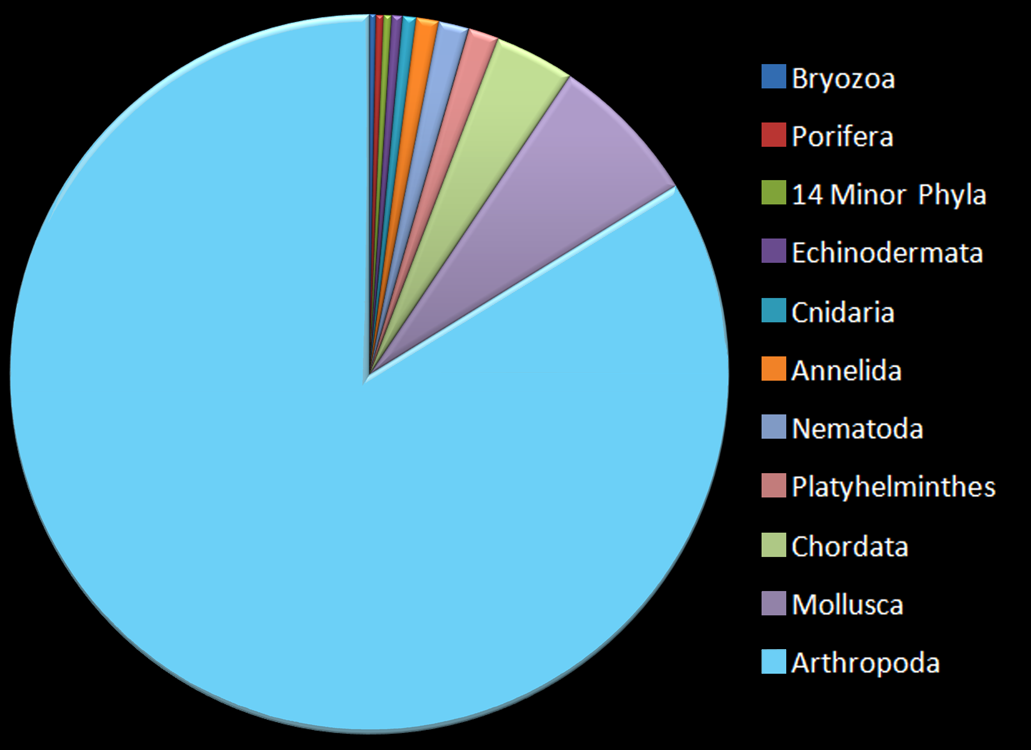
In the kingdom Animalia, there are phyla of invertebrates and vertebrates. The first invertebrate phylum is Porifera, or the sessile filter-feeders, otherwise known as sponges. Another phylum is the Cnidarians, who are the first vertebrates to have specialized tissue. They include coral, hydras, and jellyfish. The next three phlya are closely related. Platyhelminthes are flatworms with an incomplete or no gut. The three classes are planarians, flukes, and tapeworms. Molluska have a digestive system, and they are snails, slugs, clams, and squids. Finally, Annelida are segmented worms with a coelom, like earthworms. A huge phylum is Arthopoda. The two classes in it are Insecta and Crustacea. The last phylum of invertebrates is Echinodermata, who have a water vascular system with a skeleton made of interlocking ossicles. The five classes include sea stars, sand dollars, basket stars, sea cucumbers, and sea lilies. Then comes the phylum of all vertebrates, Chordata. It starts with fish, specifically the jawless fish of class Agnatha. There are two other classes of fish. Condricthyes have a skeleton made of cartilage, and Osteicthyes have a bony skeleton. After the tranistional forms of fish climbed up onto land, the amiphibians (Amphibia) came into being. They include the salamanders, caecilians, and the frogs/toads. Reptilia is the class with the crocodilians, snakes, lizards, and turtles. They are ectotherms with a three-chambered heart and a cloaca. Aves (birds) evolved from therapod dinosaurs, and they have wings, feathers, and re-arranged hip muscles. The last and most recent class is the class Mammalia. Mammals are complex, social organisms with hair, a chewing jaw, and a four-chambered heart. The three gruops are marsupials, monotremes, and eutherians, or the most recent mammals. In each ensuing phylum and class, there is more diversity and more helpful traits that all lead to the existence of humans. As life went on, speciation and evolution occurred to create the organisms that exist today.
https://upload.wikimedia.org/wikipedia/commons/thumb/a/a5/Biological_classification_L_Pengo_vflip.svg/399px-Biological_classification_L_Pengo_vflip.svg.png
I wonder about what species we still have to discover and how we will classify them. There are so many species in the world that humans have not discovered yet. New phlya and classes could be created to accommodate a new, diverse species. Also, all of these organisms lived during different time periods, and we did a project showing a timeline of Earth's history. Click here to see my reflection on the project. In this unit, we also did presentations about different organisms to show exactly what on Earth evolved. My presentation went well and I was able to be in the time limit range. I believe that this is because I was well prepared, I practiced beforehand for my presentation, so I didn't read from my slides as much. One thing I could have improved on was putting less information onto the slides and not relying on it so much. By that, I mean that I could have spoke more from my own memory and not crowd the slides with information. I could have used it more as an aid than as the basis for my speaking. This gave me valuable experience with public speaking, as I will certainly have to do more of it in my life. I practiced speaking in front of an audience, and I got to see other people do it too. I learned a lot about other organisms on Earth, and each one was taught be a different person. Below is my presentation about the Australopithecus, the first ever upright-walking hominid.


No comments:
Post a Comment